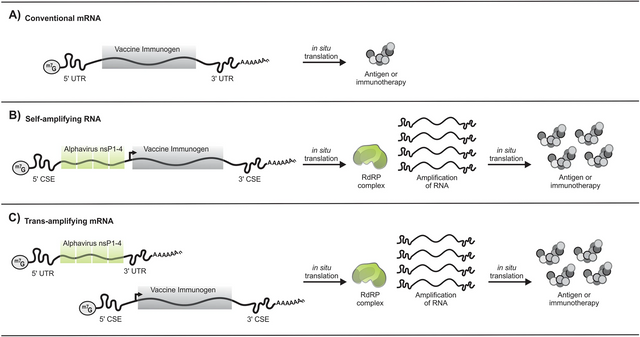
We live in an era when advances in molecular biology are occurring at the kind of exponential rates we usually associate with the meteoric rise of computing technology. Just as we get our head around the idea of mRNA vaccines... it appears there might be a better way.
A quick review:
The four nucleotide bases that make up RNA are (abbreviated) A, U, G, and C. (This is similar to DNA's A,T,G,C, except that RNA substitutes uracil [U] for thymine [T]). DNA is packaged in pairs of strands, and we are accustomed to thinking of them as a template strand and a coding strand. During RNA transcription, the DNA template strand is used as a blueprint to create RNA, and the specific pattern the RNA takes is (hopefully!) an exact copy of the coding strand, but with mRNA substituting a U anywhere the coding strand has a T.
Think of mRNA as a "positive sense" oligo: the ribosome can directly translate this RNA into the corresponding protein. This is how positive sense viruses work, and this is how mRNA vaccines work: they contain an RNA sequence that the cells of your body translate into a protein. In the case of an mRNA vaccine, this protein is the antigen that we wish to provoke an immune response to.
Note that the amount of protein product obtained is directly proportional to the number of copies of the mRNA that are injected. To provoke the desired immune response requires injecting very large numbers of mRNA oligos embedded within the lipids that serve as their delivery envelope. The manufacture of these oligos and their envelopes is complex, delicate, and expensive.
Lets talk about viruses for a moment.
Many RNA viruses are "positive sense"... that is, they contain RNA that can be directly translated into the corresponding protein by the ribosome. (A positive-sense RNA virus is basically just a chunk of mRNA wrapped in some fat). There are also "negative sense" viruses that contain a (template) for their RNA instead of the RNA itself. Before that RNA template can be translated into a protein, it must first be transcribed into RNA via an enzyme called an "RNA replicase" or "RNA dependent RNA polymerase", thankfully abbreviated as just RdRP.
These "negative sense" viruses that deliver their payload via an RNA template (instead of via the RNA itself) also carry a gene that codes for the necessary RdRP (Remember RdRP effectively serves as the mechanism for transcribing template RNA into RNA that can be translated). When the portion of the viral genome containing the RNA blueprint for RdRP gets translated by the ribosome, the appropriate RdRP enzymes get created, find their way to the part of the virus containing the RNA template, and proceed to manufacture dozens of replicates of the matching RNA. (Which are then themselves translated by the ribosome into the corresponding proteins). In this way, a negative-sense RNA virus can be said to be "self-amplifying". Once the RNA blueprint for RdRP has been translated into an actual enzyme, that enzyme can generate many copies of the RNA viral payload.
To deliver an RNA oligo for the purposes of vaccination, what if we used a negative-sense virus (which includes an RNA template for the payload, and the RNA for the RdRP necessary to transcribe RNA from that template), and replaced the virus's payload with the template for the RNA that we wish to deliver? In this way, our "self-amplifying" RNA (or just "saRNA") would allow us to deliver much smaller doses of the vaccine, tremendously expanding the manufacturing efficiency and hopefully lowering costs.
A slight subject change:
Malaria kills more than 400,000 people a year, mostly children under the age of five. No effective vaccine exists. GSK just filed a patent for a saRNA vaccine that could be a game changer. Human trials haven't started yet, but the recent success of mRNA vaccines against SARS-CoV-2 make us hopeful.
Here's a great paper by Dr. Kristie Bloom published in "Nature : Gene Therapy" a few months ago. Even if you don't read the entire paper, the first two sections ("Abstract" and "Introduction") are enough to help get your head around self-amplifying RNA (saRNA) and why it's likely to be a significant advance in the ages old battle against disease.
And here's to hoping that GSK has an effective vaccine for a disease that kills four million kids every decade.